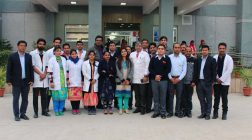The Golden Age of Healthcare Investing is Now
The human genome evolved for us as Paleolithic cavemen, arming us to cope with leopards, communicable diseases, infections, parasites and starvation. But modern society has succeeded in taming most of those risks, and now, ironically, our biggest health challenges are largely a byproduct of our success. As we extend our lifespan, cancer and cardiac disease increase in incidence. We confront an epidemic of diabetes and obesity related diseases largely caused by overconsumption and inactivity. Our genome never evolved to benefit obese 70 year olds. Cavemen didn’t typically live past 40 and didn’t drink high-fructose corn syrup in Big Gulps.
Fortunately, modern technology is picking up where the human genome left off. Medicine is finally moving fully into the Information Age. Medical data is exploding and becoming increasingly digital. It is being aggregated and correlated in our electronic medical records (EMRs). All kinds of associations are waiting to be discovered in this mass of medical data we are suddenly aggregating.
As the data proves, there’s lots of action in healthcare information technology, $1.2 billion was invested in 163 VC deals last year, up impressively from $483 million in 49 deals in 2011, according to recent research from Mercom Capital.
Not surprisingly, big data increasingly is mentioned in the same breath as healthcare and venture capital investment. Investment opportunities abound in the mountains of data produced by the healthcare industry: identifying disease trends across patient populations, sharpening medical best practices, detecting insurance fraud, and testing variables across a population of patients that might help reduce the risk of developing a particular disease.
Not only are companies combing through this data, but also they are developing new technologies, many of which are consumer-facing, to collect new information. On the front end, for example, new mobile applications enable researchers and healthcare providers to more easily gather patient data directly from consumers. Software has been developed to measure blood pressure with an iPhone, or turn the device into a heart monitor. Activity tracking devices can fight obesity by monitoring users’ physical activity, body mass index and weight.
And we are finally getting a chance to read our personal instruction manuals, i.e. our genomes, proteomes, communicomes, microbiomes and viromes. Doctors can now see a disease risk developing before patients even feel symptoms. And providers can use genetic data to custom tailor the right therapy, or even the right screening frequency.
Imagine a future where your physician knows you’re sick before you do or where personalized, genetics-based decisions about the effectiveness of a drug are predetermined using microchip technology or your stored genome in your EMR. This future is much closer than most people think. We can now know which drug is going to work best on an individual, or which embryo is carrying a serious mutation, or which individual is benignly carrying an infectious agent or recessive genetic defect.
Startups are cropping up to harness the reams of data in our personal instruction manuals, using genomic diagnostics to develop diagnostic tests and treatments for cancer, cardiovascular disease and other ailments.
The definition of disease itself is going to undergo a major advance in the next decade. It’s already happening. Twenty-five years ago, most people identified diseases by the organ system they struck. You had the stomach flu or breast cancer or kidney disease. Today, with personal genomics, we are able to decode the molecular mechanisms involved in disease.
Decoding the human genome and the mutations involved in cancers, profiling the circulating proteome in an individual’s bloodstream, understanding the epigenomic memory overlaid on our genome, differentiating infectious agents by understanding their pathways and mechanisms – all these informatics revolutions are happening now.
We are heading toward the concept of personalized pharmacology. This means drugs that are custom tailored to work on your unique genome, molecular pathways and mutations. Someday soon, Walgreens will need access to your EMR to better define your prescription. And in the not too distant future, your pharmacist may be formulating a drug cocktail or even molecular structure to directly address your particular molecular pathway defect.
Standardized drugs won’t go away, but they will be increasingly custom-formulated or custom-combined. Clearly, many pathways will be shared by individuals but often in unique combinations. Drug companies may find that in addition to standardized drugs, they are also providing components of drug cocktails. These components would then be custom combined to meet an individual’s specific needs. In short, personalization will increasingly mean formulation closer to the customer, based on that customer’s specific characteristics.
In the near term, drug developers will need to be thinking about the companion diagnostics that have to be paired with their drugs. As new drugs are better focused on each individual patient’s defective pathways, “rifle shots, not shotgun blasts”, the doctor will have to provide more information about the patient to allow the most accurate selection of treatment.
I believe we are entering a Golden Age of Healthcare in the next decade. Finally we are seeing, and treating, the molecular mechanisms of disease. Finally, we are seeing the differences in people’s molecular pathways and able to customize treatments to each individual’s situation. Finally, civilization has advanced enough that we can effectively update evolution to adapt us to our modern world, correct our genetic obsolescence, prevent aging related degeneration and help us cope with the excesses of modern life.
Medicine is becoming the quintessential Big Data problem. We are all just piles of carbon and oxygen and nitrogen. What makes us different is how those atoms are arranged and interact. This is information. And it means therapeutic decisions must also be personalized, including the drugs to treat each individual’s unique illness and genome. Healthcare IT — and investment in this field — will lead us to this Golden Age.
Ted Driscoll is a director with Claremont Creek. Opinions expressed here are entirely his own.










